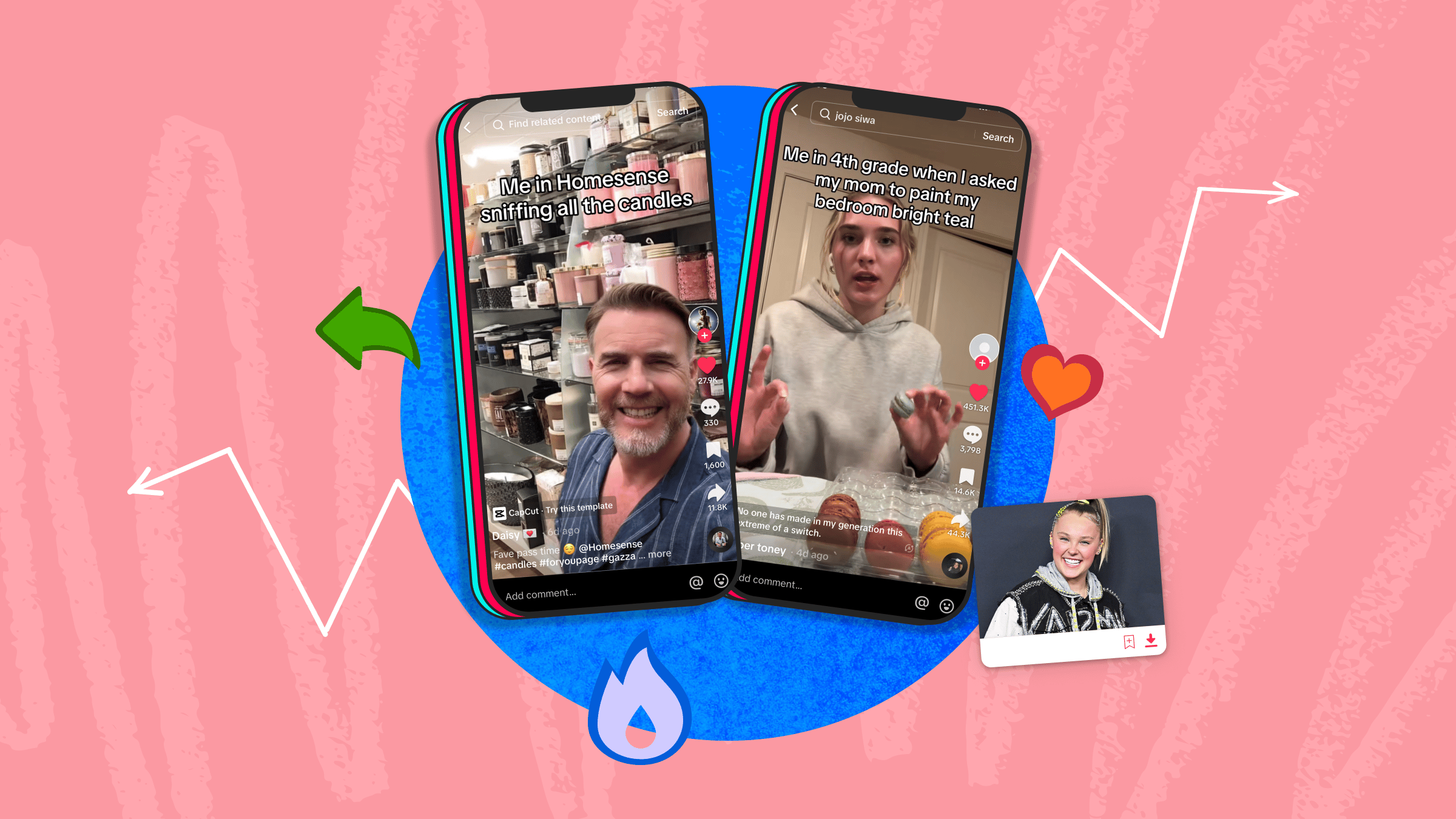Whether you’re completely new to social media marketing or just need to update your strategy, we’ve got you covered with this step-by-step guide.

Social media is huge. So huge, in fact, that more than half the globe is active on one social media platform or another, with more joining in every day. This makes having a presence on social media essential for businesses as a way to connect directly with this large pool of potential customers through social media content.
But how do you make the most of the opportunities out there, and set about creating the most effective content for promoting your goods and services to this audience? That’s where we come in. We’ve created a comprehensive, step-by-step social media marketing guide, with you in mind, so that whether you’re completely new to social media marketing or just need to update your strategy, we’ve got you covered:
And if video is your focus, discover how to create social media video!
What is Social Media Marketing?
Social media marketing is the process of creating and posting content that you have customized for each social media network, to achieve a specific marketing goal, like promoting your brand, driving audience engagement, boosting user acquisition, or motivating users to make a purchase.
Chapter 1: The Benefits of Social Media Marketing

1. Build Brand Awareness
Using social media platforms is a great way to generate awareness about your brand. In fact, according to a report by Oberlo, 54% of social media browsers use social media to research products. This finding suggests that, with over a billion users eager to discover new brands and their offerings, every business should take social media marketing seriously.
2. Build an Engaged Community
Connection and engagement are at the heart of social media, and one of the greatest benefits of social media marketing for a business is the opportunity to interact with customers from all over the world. It’s never been easier to develop a community of dedicated fans who you can communicate with directly and who, once you win them over, will sing your brand’s praises to all their friends and followers.
3. Enhance Brand Loyalty
Not only does using social media support direct communication with potential and actual customers, but a study conducted by the International Journal of Research Marketing reveals that engaging a user through social media forges a stronger relationship between the consumer and the business, and enhances brand loyalty.
4. Show Off Your Commitment to Great Customer Care
In the past, when we had a problem with a company our only options were to call or write to them directly, or simply vent our frustration to our friends, but now people tend to share their dissatisfaction with a much larger audience via social media. This gives those businesses that are paying attention an opportunity to resolve issues quickly and efficiently, and to demonstrate to hundreds, thousands or millions of potential customers that you care about them and want to provide them with the best possible experience.
5. Target Specific Demographics
One of the best things about social media marketing is that businesses can target their messages to reach the right groups of people. That’s because different demographics tend to favor different social media platforms and vary in how they use them. On top of that, each platform collects a certain amount of information on its users, which allows you to target even more finely tuned messages to particular audience groups.
6. Open New Avenues to Promote and Sell
Social media facilitates a new way to connect with potential customers, known as ‘social selling’. With social selling, a salesperson reaches out to a potential customer directly, via social media, to offer thoughtful suggestions, answer questions, and accelerate them towards a purchase. Unlike cold calling, which has a reputation as annoying and intrusive, selling on social media tends to be received more favorably.
7. Support Multi-Channel Campaigns
Social media marketing is most effective when applied across several different social media platforms and marketing channels. That’s because it allows you to reinforce your message via multiple social media channels, thereby continuing a conversation with your audience over a period of time.
As you’ve probably noticed, the benefits of social media marketing aren’t all about direct sales, but rather about building brand recognition, generating a community of actual and potential customers, and helping your business to become profitable over time.
Now that you have a good idea of what social media marketing is, and some of the benefits of this approach to marketing, it’s time to look at creating an effective social media marketing strategy.
Chapter 2: Building a Successful Social Media Marketing Strategy
A social media marketing strategy is a plan for everything you hope to do and achieve using social media. It’s designed to guide your actions and track whether you’re succeeding or failing.
In this section, we’ll share the ingredients for a successful social media strategy.
1. Set Social Media Marketing Goals
You can’t move forward without knowing what you’re working towards, so your first step is to set your social media marketing goals. Start by examining your company’s overall business goals and then think about how you want to use social media to help you achieve them. Having too many goals can be distracting and counterproductive, so limit yourself to two primary goals and two secondary goals.
Each goal should adhere to the SMART framework, meaning they should each be:
- Specific
- Measurable
- Achievable
- Relevant
- Time-based
For example, instead of your goal reading “Build a loyal following”, it should read “Grow account from 0 to at least 10,000 followers (specific and measurable) in 6 months (time-based and achievable) using high-quality images, videos, infographics, giveaways and customer-generated content (relevant).”
Using SMART goals gives you a foolproof way of ascertaining where your social media strategy is succeeding or failing.
2. Identify Ideal Customers
Effective marketing is impossible without knowing who your target audience is, which social media platform they prefer, and what they care about. The more information you have on your ideal customer, the better equipped you are to create content that they’ll like, engage with and share, and the greater the likelihood that you’ll be able to convert these fans into customers.
The first step in understanding your ideal customer is to create an ideal customer profile, the point of which is to arrive at your best guess at the kind of person who might most readily convert into a customer.
Facebook is a great platform for helping you to develop an ideal customer profile. As one of the largest social networks, with a database of almost 3 billion active monthly users, it is a great place to do some audience research.
Start by checking out your competitors’ pages. Click through to the profiles of a handful of their most engaged followers to get a sense of who they are and what they care about. Once you’ve done this a few times, you’re ready to create a profile of the kind of person who is most likely to buy from you.
Details should include:
- Gender
- Age
- Relationship status
- Location
- Interests
- Job title
- Income
- Preferred social network
- Buying motivation
- Deterrents to buying
Such insights into your ideal customer allow you to refine your social media marketing strategy and think more clearly about what to offer them.
3. Select Your Platforms
There are hundreds of social media platforms out there, and at least 20 are considered the most popular. One of the mistakes that businesses new to social media marketing make is trying to build a presence on more platforms than they can maintain.
But here’s the thing: your ideal customer is most likely using just one to three of those platforms, and probably has one identifiable favorite. For example, they may have a Facebook account that takes up only 5% of their social media browsing hours, whereas they have an active presence on Instagram 60% of the time and on Twitter the remaining 35% of the time. This insight immediately tells you that you need to focus your primary efforts on Instagram and your secondary on Twitter.
Once you’ve selected the platforms you’re going to focus on, you need to create a separate content strategy for each. Every social media platform works differently and manages some content better than others. On one platform, video content is king, on another, it will be still images, and on another, short text is the way to go. So if you decide to focus on Instagram, Facebook and YouTube, you’re going to need specific content approaches for each.
4. Create a Social Media Content Strategy
Now it’s time to focus on your social media content plan. Because content is so critical for businesses, we have dedicated the next entire chapter to our top social media content ideas. Here, we’ll focus on a few actionable steps for creating a social media content strategy.
Conducting a social media audit:
Audit your existing social media channels to evaluate your past efforts and assess whether the platforms you’re currently using are the right ones for you, based on your new marketing goals and target audience. If a platform is no longer viable, given your goals and target audience, plan to pull back efforts on it so that you can spend more time focusing on more relevant platforms. If you’re going to continue your marketing efforts on your existing channels, make sure that all links are updated and that the company information is consistent with your current brand image and standards. Evaluate the performance of your posts and plan to do more of what has worked well and less of what hasn’t.
Check out the competition:
It’s always a good idea to keep an eye on your competitors’ social media channels, because they can give you loads of insights into how your niche performs on different platforms. You can also draw inspiration from your competitors’ social media content plan, uncovering the strengths and weaknesses in their approaches and their products. All of this learning can be used to inform your own strategies.
Scott Chow the founder of The Blog Starter explains, “when you are starting out, keep an eye on your competitor’s social media activities manually. Analyze what type of content works for them on which platform, how frequently do they post, when do they get maximum engagement, how do they respond to followers’ comments. This data can be gold for you. It will help you build a comprehensive social media content strategy.”
Decide on the types of social media content you’ll be focusing on:
Depending on the channels you’ve chosen, decide on the types of social media content you use could include – images, videos, Instagram Stories, IGTV, interviews, company news or user-generated content. Whatever you choose, your content needs to fit with your company’s voice and your target audience’s tastes. It must be high quality and engaging and align with the goals and objectives that you identified in Step 2.
Determine posting times:
Your social media content plan should also include guidance about what time of the day or week is best for posting your content. For example, if you’re based in Europe and your client base is in the Americas, posting later in the day may be preferable. You can always test this out by posting at different times to figure out which posts generate the most engagement from your audience.
Establish a posting frequency:
Finding the perfect frequency is critical for engagement. You don’t want to post so much that you annoy your fans or followers, nor do you want to post so infrequently that they forget you.
Create a social media content calendar:
Once you’ve determined the types of social media content you’ll be sharing, the time you’ll be posting, and your posting frequency, create a social media content calendar that outlines how often you will post to each network, which content you will share, and when you will share it.
5. Schedule, Track, Analyze, Optimize
Let’s face it, social media marketing is time-consuming, and there just aren’t enough hours in the day to keep up – even if you’re a dedicated manager of your company’s social media accounts. That’s why social media management tools are a marketer’s best friend.
Social media management tools enable you to schedule posts for publication ahead of time, manage conversations and engagement, and track and analyze data and responses to your strategies to gauge whether your objectives are being met.
Regularly tracking and analyzing data allows you to tweak your strategy to be as effective as possible, course-correcting when results are poor or doubling down on efforts that are successful.
Here are a few tools that will make your job considerably easier:
- Buffer allows you to schedule posts of all types across any platform. It also gives you the tools to evaluate which posts are most effective and why.
- Hootsuite is another tool like Buffer that allows you to schedule posts on a number of different social media platforms and analyze content performance.
- HubSpot offers a host of tools for social media marketing, content management, web analytics, search engine and landing page optimization.
- Sprout Social is a social media management tool that enables users to publish content, analyze performance and monitor engagement.
- Tagboard is a social listening tool that allows you to monitor like brand or product mentions. You simply enter the topic, hashtag or term you’re interested in and you’ll see how the search term is being talked about in the social sphere.
- Bitly enables you to shorten any URL so that it fits perfectly on your social media channels, and allows you to track responses each time a link is clicked, giving you valuable insights that will help you to optimize your marketing efforts.
- Milkshake App is a free mobile website builder allowing you to build a website on your phone in minutes to make the most of your social media link in bio. This app enables you to not only feature multiple links in your bio, but also feature your online store, contact info, location, customer reviews, booking details or anything else you want to feature.
- NapoleonCat is a social media management tool that will help you keep up with engagement across all major social platforms. Plus, you can schedule your posts to multiple platforms and profiles.
Developing a social media strategy is demanding, it requires intentional and long-term investment, but it will be enormously beneficial to you and your company. An intelligent social media marketing strategy ensures that you aren’t just churning out content for the sake of it, but instead proactively moving towards achieving your business goals.
Chapter 3: Creating Engaging Social Media Content
High quality, engaging content is the fuel that successful social media strategies run on. That’s why we’re dedicating this chapter to our top social media content ideas.
What Is Social Media Content?
Social media content encompasses all of the materials marketers use to attract and engage social media users and persuade them to take a specific action. It includes but isn’t limited to images, videos, gifs, illustrations, Instagram Stories, and infographics, which should establish your company’s unique brand and create a connection with your audience.
Here are our top tips for creating shareable content for social media.
1. Develop a Process
As we’ve said before, each piece of content you create should relate to your social media marketing goals and objectives for the platform you’re posting on. With this in mind, establish a process that follows these steps:
- Select one of your objectives for the platform.
- Brainstorm with colleagues about the approach and content that would achieve this objective.
- Assign roles and responsibilities for creating the content.
- Create content.
- Schedule content for publication.
- Monitor and respond to comments and queries.
- Track and analyze responses.
- Tweak your strategy to course-correct when results are poor or double down on efforts that are successful.
2. Create Content With Your Audience in Mind
Every form of social media content you create should not only be designed to achieve a specific objective but should also attract the attention of the ideal customer you identified in the previous chapter. Ask yourself if what you’re planning to create is really something they will engage with, share with their friends or take some other action on.
When you’ve developed your idea, you may even decide to poll your audience to see what they think of it. This kind of approach generates engagement and gives you valuable insight into what your target audience wants.
3. Develop Your Voice
Developing your voice requires you to marry what your company stands for and represents, with the needs of your target demographic. Knowing your ideal client helps you to develop a voice and tone for your brand that will resonate with them. To find your voice, ask yourself:
- What kind of personality would your company have if it were human?
- As a person, how would it treat others?
- What do you want customers to think about your company?
- Based on your answers to the above, what is the tone of your company? Serious, funny, knowledgeable, friendly or something else?
Once you’ve decided on the right voice for your company, create a social media style guide to document and formalize all of your decisions about voice, tone, and style. This will be instrumental in keeping your branding consistent, even when you have different people working on your social media team.
4. Trigger Emotions
Human beings share certain psychological needs, so most of us experience the same basic response to certain emotional triggers, which in turn drive our behaviors. Understanding what those triggers are and how to use them to achieve a specific response is the bread and butter of creating great marketing materials. Here is a list of the most popular emotional triggers, with examples of the kind of copy that aims to tap into each emotion:
- Leadership – Be the first of your friends to discover the power of xyz.
- Value – It’s our gift to you.
- Instant gratification – Try today at our risk.
- Belonging – Join us today and see what you’ve been missing.
- Fear – Don’t miss out.
- Guilt – For just $5, you can make all the difference in the life of a child.
- Time – Offer lasts until midnight.
- Trust – No hidden fees.
- Competition – Be the envy of all your neighbors.
- Trendsetting – Be like your favorite celeb.
5. Create a Mixture of High-Quality Content
The best approach to social content is to use a good mixture of approaches to keep your target audience entertained, engaged, and occasionally (even frequently) surprised. The various formats below are just a few of the most popular types of social media content that you should experiment with.
Images
When it comes to content creation, images are hands down the most popular choice. And considering that posts that contain images are shared 94% more than posts that don’t, it’s no wonder. Images are easy to create, they tell a story, they reinforce messages, and they are ultra-shareable.
Video
With its irresistible combination of moving image and sound, video is a wonderful storytelling medium that works well in long or short form, across a variety of social media channels. No social media strategy is complete without an element of video content. If you’re worried that your budget can’t accommodate the regular use of a team of video experts, Placeit has a wide and wonderful selection of Video Templates that you can use on any platform. For more on this format, check out our guide to social media video.
IGTV
IGTV Series are absolutely exploding on Instagram right now, and are a great addition to your social media marketing strategy.
Rather than producing one-off videos on a semi-regular basis, creating a series of videos is a surefire way to increase your reach, up your engagement, and keep your followers coming back for more.
Live Content
With the advent of live streaming on Facebook and Instagram, brands are finding innovative ways to use the medium to their advantage. Some of the most effective uses are:
- Customer support
- Product introductions
- Interviews and influencer outreach
- Live events
- Behind-the-scenes glimpses
- Q&As and conversations with your audience
- Tutorials
Illustrations
Illustrations are a wonderfully entertaining and unique way to attract an audience and tell stories that get your point across.
Carousels
Instagram’s Carousel feature gives brands yet another creative way to intrigue audiences or tell a story. Your audience can swipe through the slideshow as if turning the pages of a book and, best of all, you can also create slideshows with slideshow video templates.
Infographics
Infographics are interesting and educational. They pull viewers in and keep them hooked. If you need to create an infographic but are not sure where to start, Envato Market and Envato Elements both have some great templates that can help you get started.
Giveaways
Giveaways are a no-brainer when it comes to social content. There are several approaches to offering a giveaway, and your choice of strategy should depend on your objective and the types of actions that you want your target audience to take. The most popular types of giveaways are:
- Follow/like/comment to win contests
- Tag a friend
- Post a specific type of picture
- Share and hashtag a post
6. Jump on Trending Topics
Trends may come and go, but while they’re around they gain a lot of attention. You can ride the wave of their popularity and pull some of it your way if you stay up to date with trending topics and use them to create shareable content when appropriate. Here are a few ways to keep up:
- Create a stream on Twitter with popular hashtags like #socialmedia
- Create a Twitter list of key influencers and spend a bit of time each day reading what they’re saying
- Use a news aggregation RRS feed to centralize news from a selection of different sources
- Set up Google Alerts on specific terms and influencers to get regular updates when they post
- Keep an eye on your competition
- Don’t forget good old networking at local events, conferences and trainings, as well as Facebook groups
7. Use User-Generated Content
One of the most popular trends in content creation is to include customers in the creation process. This is known as user-generated content and enables your fans and followers to become brand ambassadors. There is a lot of power in ordinary people vouching for a brand. According to Adweek, customer-generated content results in 29% higher web conversions than campaigns or websites that don’t use them, and 45% of marketers agree that user-generated content improves their social media campaigns. This is a good reason to actively encourage your fans and followers to show you how they’re using your product on their own social media and then share their content on your social media platform.
8. Use Online Tools and Templates
Great social media content doesn’t have to break the bank. There are tons of useful tools and templates available online that are cost-effective and will help you get the job done quickly and easily. For example, Placeit has a number of excellent ad templates for use on Facebook and Instagram, as well as several cool video ad templates. In addition, if you are proficient in Adobe software you’ll find loads of useful templates on both Envato Elements and Envato Market.
Chapter 4: Social Media Advertising & Campaigns

As you become more confident with social media marketing, you may want to start dipping your toes into the world of social media advertising. It can be a bit daunting stepping up from an organic strategy to one that requires you to invest your cash, so we thought it would be a good idea to round off this guide by looking at the top things to consider when creating social media ads, and then offering an overview of a few of the different types of social media advertising available today.
Top Things To Consider When Creating Ads
1. Repeat the Steps Used for Social Marketing
Many of the same steps that apply to your social marketing strategy also apply to your social media ads strategy. You must set objectives and goals, keep sight of your target audience, track and analyze data, and measure results.
2. Use the Same Channels That Work Well for Your Organic Content
When thinking about which social channels to use for advertising, the best approach is to use the same channels that have proven effective for your organic content. That’s because channels on which your content already resonates with your target audience are also likely to offer success with your social ad campaigns.
3. Test Multiple Versions of an Ad
One of the best things about social media ads is instant feedback. Create and run different versions of an ad for a short time to see which gets the best response. For example, you could create two identical ads with different headlines, images, copy or call to action, to see which of the two generates the most attention. Just be sure to change only one element of your ad at a time so that you can pinpoint which element has made the difference.
Different Types of Social Media Advertising
Several of the major social media platforms offer advertising options, but not all of them will be the right fit for every marketer. Here’s an overview of the more popular channels for social media advertising, with the type of ads they offer.
1. Facebook Ads


With almost 3 billion users worldwide, advertising with Facebook is hard to beat, especially because the social media giant offers filters that allow users to specify their target audience based on factors like age, gender, location, interests, etc. Facebook ads can take a number of forms, including photos, videos, slideshows, etc. They are designed specifically to help brands achieve three types of goals: awareness, consideration, or conversion.
2. Instagram Ads




There are a couple of qualities that make Instagram an attractive platform for advertisers. Firstly, according to Locowise, Instagram’s engagement rate is even higher than Facebook’s – a whopping 70% higher to be exact. Secondly, Instagram offers a lot of variety as ads can take the form of photos, videos, and carousels. In addition, you can create each type of ad for either the main Instagram feed, an Instagram Story or IGTV. Instagram ads support the same three broad categories of campaign objectives as Facebook ads: awareness, consideration, and conversion.
3. Twitter Ads




Twitter, unlike Facebook, is still a viable network for organic engagement. However, with various attractive advertising campaign options on offer, like promoted accounts, tweets, trends and website cards, there’s still good reason to spend a portion of your social media ad budget on the platform. Twitter ads are designed specifically to help brands achieve website clicks or conversions, tweet engagement, an increase in followers, greater brand awareness, etc.
4. Pinterest Ads




With 81% female users, Pinterest is widely regarded as a women’s channel. According to the Feed Marketing Report data, Pinterest is among the only two social channels that qualified to be the top 10 global advertising channels in 2022. Pinterest ads are called Promoted Pins. They look and behave just like regular pins but you pay to have them seen by a wider audience. Pinterest offers a strong platform for e-commerce sales, and is useful for driving traffic to your website, building brand awareness, and encouraging audience engagement.
5. YouTube Ads


YouTube is the only social channel used by slightly more men than women. YouTube ads are great for helping you attract new viewers, build brand awareness, extend reach, drive website traffic and grow your subscriber base.
6. LinkedIn Ads


LinkedIn is the platform of choice for those interested in B2B. It connects over 300 million professionals and offers text ads, sponsored content ads and sponsored InMail to help drive website traffic, build brand awareness, generate leads and convert prospects.
If you’re looking to create your own social media ads, Placeit has a number of great templates for Facebook, Instagram and YouTube that will get you up and running in no time, at an affordable price. If you are looking to manage and automate your social media ads across all your channels at once, you may want to invest in one of these top Wordstream alternatives tools.
For those who are competent in Adobe Photoshop and Illustrator, there are tons of ad templates available for various social media platforms. For example, check out the Facebook Fashion Banner Ads by micromove on Envato Elements, or this collection of 1650 Facebook and Instagram Ad Banners by Hyov on GraphicRiver.
Not to be left out, there are also lots of great templates for those of you proficient in Adobe Premiere Pro and After Effects, like this Social Media Ads pack by Madlistudio from VideoHive.
We know that we’ve given you quite a bit to think about and take action on, but the bottom line is that no viable business today can afford to ignore social media. At the same time, we hope you now feel reassured that establishing a presence on social media doesn’t have to be overwhelming and unmanageable. Like so much else in life, it’s all about having a plan, using the available tools and resources to make your task easier, and taking incremental steps towards your goals.
Now that you understand how to develop a social media marketing strategy, how to create irresistible content, and how to step up to social media advertising when you’re ready, you are more than prepared for the journey ahead. Go forth, spread your wings and become a social media butterfly!











